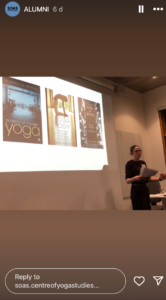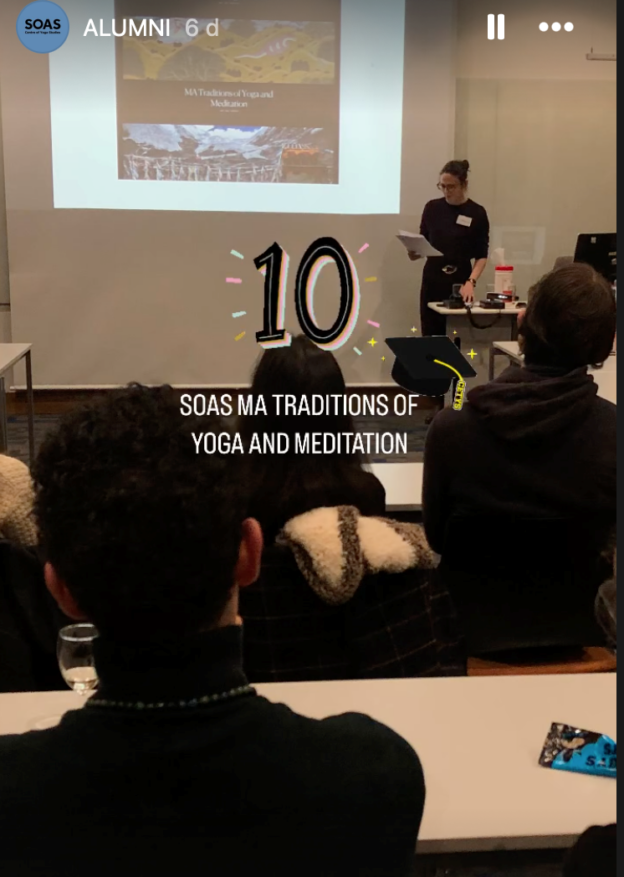Recently I was asked to reflect upon the growth of the field of ‘Yoga Studies’ – the academic study of yoga in the disciplines of yoga and social sciences to celebrate a decade of successful graduates from the MA in Yoga Studies at SOAS. The evening celebratory event was enthusiastically well attended by at least one-third of the graduates of the programme.
This occasion made me feel both old and grateful that I could reflect upon the establishment of Yoga Studies as a sub-field through lived experience. I started researching contemporary or ‘modern yoga’ (although it wasn’t yet a term) in 2002 as part of an MSc in the Sociology of Religion. My question then was what are the beliefs of yoga practitioners and how do they relate to religion? (For more how I framed and answered the question at the time, see Hasselle-Newcombe 2005)
But as I was doing this research I realised there were more basic and obvious questions.
- Why was doing something called ‘yoga’ both incredibly common and normal? Wasn’t yoga something from another culture? How and why did this happen?
I realised that these questions would keep me busy for a PhD, which I began in 2003 and was eventually published as a monograph Yoga in Britain: Stretching Spirituality and Educating Yogis (2019).
But of course, I wasn’t the only one interested in this question. Elizabeth de Michelis’ A History of Modern Yoga: Patañjali and Western Esotericism (2004), marked a pivotal moment, defining ‘modern yoga’ as a practice with distinct characteristics from its premodern roots. During the same year, Joseph Alter’s Yoga in Modern India: The Body between Science and Philosophy was also published. In the next two decades these books were followed but an exponentially increasing number of academic publications and insights.
I was lucky enough to be part of many of the initial discussions facilitated by Elizabeth de Michelis as the director of the Dharam Hinduja Institute of Indic Research at the University of Cambridge between 2000 to 2006. She brought together most of the scattered scholars in the social sciences and humanities who were looking at contemporary yoga for a series of conferences and workshops.

My PhD research was very much shaped by these dialogues, particularly through discussions with Elizabeth and Mark Singleton undertaking the PhD research which underpins Yoga Body (2010) at the time. The extant academic research on yoga was possible to keep in my head during my PhD. But now I must do a fresh literature search every time I want to write about the field because something new has always been published by someone I’ve not yet encountered.
The questions from which I started my PhD research were naïve, general and basic. Now the questions that preoccupy the growing number of yoga researchers are more nuanced and much more specific, for example:
- How are the soteriological goals of yoga expressed in different times and places? What are the commonalities and differences in these goals and experiences?
- How do the experiences of yoga practice relate to more contemporary psychological descriptors such as flow, absorption – or modern ideas of ‘concentration’ and meditation?
- What other traditions of physical and spiritual practice have been incorporated into contemporary yoga contexts? When and how do these transformations of practices occur?
- How have our current understandings of ‘meditation’ and ‘yoga’ been established? Do these words adequately describe either the experiences or motivations of practitioners?
- How might we use the nuanced discussions found in historical texts to explore the nuances of practitioner experiences and diversity of practices found in contemporary yoga and meditation?
- Where, how and in what ways does yoga recapitulate power imbalances and systemic oppressions? How does this happen in similar and distinct ways in different times and places?
Scholarly research has now definitively demonstrated that yoga is not always anything: Yoga is not always good. It is not always healthy. But neither is it always abusive. Sometimes it is found deeply entangled within a particular religious framework, while at other times it functions as a form of physical culture devoid of reference to transcendental meaning systems.
Yoga Studies is now established as sub-discipline within Religious Studies, this is evidenced by the Yoga in Theory and Practice sub-group of the American Academy of Religion (est. 2006) as well as the several MA programmes in yoga studies, e.g. SOAS (est. 2012), Ca’ Foscari University, Venice, Italy (est. 2012) and Loyola Marymount (est. 2013). Predating these US and European initiatives was the Department of Yoga at Wonkwang University in South Korea (est. 2000) and the health and traditional philosophy-oriented approach promoted in India, e.g. Swami Vivekananda Yoga Anusandhana Samsthana (S-VAYAS) (est. 1988 and promoted to university in 2002).
The growth of the MA programmes in the European-American context is particularly interesting because they primarily attract students who are both teachers and committed practitioners of contemporary yoga. These students are also yoga professionals who want to bring their studies directly and immediately into practice outside of the traditional university context. Increasingly, established yoga scholars are asked to appear as guest lecturers as part of yoga teacher-training courses or as one-off lectures.
There are also a growing number of scholar-practitioners publishing books aimed specifically at the teacher-training market, e.g. Wildcroft and McAtee (eds.) (2024), Sarbacker (2021), Foxen and Kuberry (eds.) (2021) and SOAS MA graduate Daniel Simpson’s The Truth of Yoga (2021). This is an interesting feedback loop, with practitioners seeking grounding and clarity in rigours academic methods that parallels the more established academic-theological methods other religious traditions.
The contemporary practice of yoga sits in different places on a spectrum of religion and non-religion in different local contexts. Likewise, its study within academic contexts is not restricted to Religious Studies or applied health contexts and can be increasingly found scattered throughout the academy – and throughout the world. Academics are increasingly under pressure to justify the existence of social science and humanities disciplines. The close association with applied yoga teaching places Yoga Studies on interesting and expanding ground.
Resources for getting further involved in these conversations can be found at www.yogaresearch.org.
Books mentioned include:
Alter, J. (2004). Yoga in Modern India: The Body between Science and Philosophy. Oxford: Princeton University Press.
De Michelis, E. (2004). A History of Modern Yoga: Patañjali and Western Esotericism. London: Continuum.
Foxen, A. and Kuberry, C. (2021) Is This Yoga?: Concepts, Histories, and the Complexities of Modern Practice. London: Routledge.
Hasselle-Newcombe, S. (2005). ‘Spirituality and ‘Mystical Religion’ in Contemporary Society: A Case Study of British Practitioners of the Iyengar Method of Yoga’ Journal of Contemporary Religion 20(3): 305-321.
Newcombe, S. (2019) Yoga in Britain: Stretching Spirituality and Educating Yogis. Sheffield: Equinox.
Sarbacker, S. (2021) Tracing the Path of Yoga: The History and Philosophy of Indian Mind-Body Discipline Albany, NY: SUNNY.
Singleton, M. (2010) Yoga Body: The Origins of Modern Posture Practice. Oxford: OUP.
Simpson, D. (2021) The Truth of Yoga: A Comprehensive Guide to Yoga’s History, Texts, Philosophy, and Practices. New York: Macmillan.
Wildcroft, T. and McAtee, H. (eds.) (2024) The Yoga Teacher’s Survival Guide: Social Justice, Science, Politics, and Power. London: Singing Dragon.

